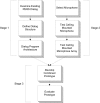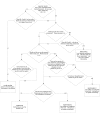Development of an automated speech recognition interface for Personal Emergency Response Systems
- PMID: 19583876
- PMCID: PMC2713250
- DOI: 10.1186/1743-0003-6-26
Development of an automated speech recognition interface for Personal Emergency Response Systems
Abstract
Background: Demands on long-term-care facilities are predicted to increase at an unprecedented rate as the baby boomer generation reaches retirement age. Aging-in-place (i.e. aging at home) is the desire of most seniors and is also a good option to reduce the burden on an over-stretched long-term-care system. Personal Emergency Response Systems (PERSs) help enable older adults to age-in-place by providing them with immediate access to emergency assistance. Traditionally they operate with push-button activators that connect the occupant via speaker-phone to a live emergency call-centre operator. If occupants do not wear the push button or cannot access the button, then the system is useless in the event of a fall or emergency. Additionally, a false alarm or failure to check-in at a regular interval will trigger a connection to a live operator, which can be unwanted and intrusive to the occupant. This paper describes the development and testing of an automated, hands-free, dialogue-based PERS prototype.
Methods: The prototype system was built using a ceiling mounted microphone array, an open-source automatic speech recognition engine, and a 'yes' and 'no' response dialog modelled after an existing call-centre protocol. Testing compared a single microphone versus a microphone array with nine adults in both noisy and quiet conditions. Dialogue testing was completed with four adults.
Results and discussion: The microphone array demonstrated improvement over the single microphone. In all cases, dialog testing resulted in the system reaching the correct decision about the kind of assistance the user was requesting. Further testing is required with elderly voices and under different noise conditions to ensure the appropriateness of the technology. Future developments include integration of the system with an emergency detection method as well as communication enhancement using features such as barge-in capability.
Conclusion: The use of an automated dialog-based PERS has the potential to provide users with more autonomy in decisions regarding their own health and more privacy in their own home.
Figures




Similar articles
-
Automated speech recognition for time recording in out-of-hospital emergency medicine-an experimental approach.Resuscitation. 2004 Feb;60(2):205-12. doi: 10.1016/j.resuscitation.2003.10.006. Resuscitation. 2004. PMID: 15036739
-
The Benefit of Remote Microphones Using Four Wireless Protocols.J Am Acad Audiol. 2015 Sep;26(8):724-731. doi: 10.3766/jaaa.15008. J Am Acad Audiol. 2015. PMID: 26333880 Clinical Trial.
-
Investigating Speech Recognition and listening effort with different device configurations in adult cochlear implant users.Cochlear Implants Int. 2018 May;19(3):119-130. doi: 10.1080/14670100.2018.1424513. Cochlear Implants Int. 2018. PMID: 29457564
-
The Personal Emergency Response System as a Technology Innovation in Primary Health Care Services: An Integrative Review.J Med Internet Res. 2016 Jul 14;18(7):e187. doi: 10.2196/jmir.5727. J Med Internet Res. 2016. PMID: 27417422 Free PMC article. Review.
-
Difficulties in automatic speech recognition of dysarthric speakers and implications for speech-based applications used by the elderly: a literature review.Assist Technol. 2010 Summer;22(2):99-112; quiz 113-4. doi: 10.1080/10400435.2010.483646. Assist Technol. 2010. PMID: 20698428 Review.
Cited by
-
Exploratory analysis of real personal emergency response call conversations: considerations for personal emergency response spoken dialogue systems.J Neuroeng Rehabil. 2016 Nov 14;13(1):97. doi: 10.1186/s12984-016-0207-9. J Neuroeng Rehabil. 2016. PMID: 27842598 Free PMC article.
References
-
- El-Faizy M, Reinsch S. Home safety intervention for the prevention of falls. Physical and Occupational Therapy in Geriatrics. 1994;12:33–49. doi: 10.1300/J148V12N03_03. - DOI
-
- Tinetti ME, Speechley M, Ginter SF. Risk factors for falls among elderly persons living in the community. N Engl J Med . 1988;319:1701–1707. - PubMed
-
- Marek K, Rantz M. Aging in place: a new model for long-term care. Nursing Administration Quarterly. 2000;24:1–11. - PubMed
Publication types
MeSH terms
LinkOut - more resources
Full Text Sources
Other Literature Sources
Miscellaneous

